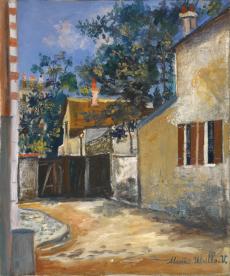


Utrillo depicted this old house in Montmartre repeatedly, but as seen from different angles, between 1923 and 1943; two older gouaches, dated to c. 1916-1918, are closer to the layout chosen in the A. G. Leventis Collection painting.1 The site in question no longer exists today: the house, formerly located on the corner of the Rue du Mont-Cenis and the Rue Saint-Vincent, where the composer Hector Berlioz lived from 1834 to 1837, was already crumbling after World War I and was replaced by a block of flats in 1925, the efforts of the Fondation Berlioz to build a museum there not having succeeded. In painting it, Utrillo showed his legendary attachment to Montmartre and offered a testimonial of a past that had disappeared or was in the process of disappearing, if the dating proposed by Paul Pétridès is correct. If we compare this work to Fontainebleau (see pp. 214-215), which is anterior by only a few years, the difference in style, method of execution and colours is easily perceptible: La Maison de Berlioz à Montmartre, painted on canvas, features a larger brushstroke and more vivid colours, notably in the green of the vegetation and the blue of the sky, which contrast strongly with the more restrained, darker tones and the more precise brushstroke of the earlier painting.
Born in Montmartre, he was the son of the painter Suzanne Valadon, who had modelled for Edgar Degas and Pierre-Auguste Renoir. He was encouraged by his mother to paint, to treat his mental illness and alcoholism, and he was trained by her. He developed an idiosyncratic style with precise brushwork in detailed, rather sad depictions of churches, factories, barracks and empty roads, which he painted from nature, from postcards or from memory. By 1910 his work attracted critical praise, and by 1920 he was internationally acclaimed.